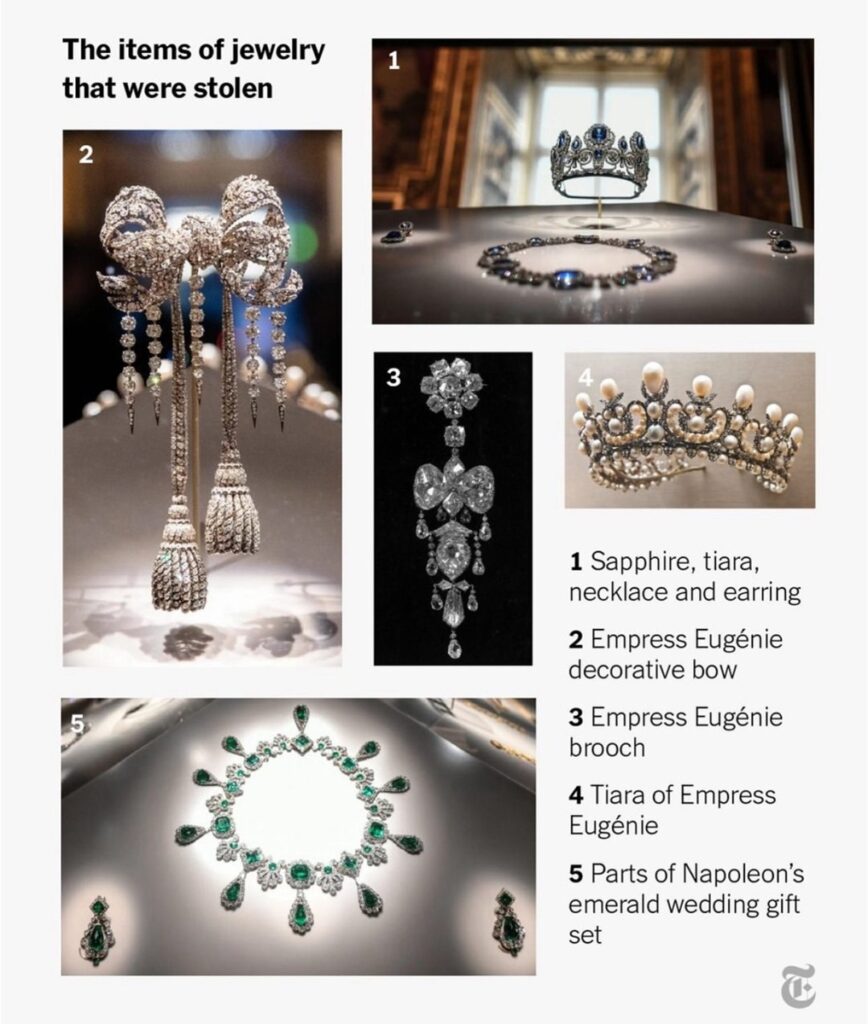A team of highly coordinated thieves executed an audacious daylight robbery at the Louvre Museum on Sunday, stealing eight pieces of priceless royal jewelry from the famed Apollo Gallery in a meticulously planned operation that lasted less than ten minutes.
The heist, which targeted historical gems once belonging to French emperors and empresses, has been described by authorities as the work of experienced professionals, and has immediately triggered a high-stakes, multi-investigator hunt across Europe.
French newspapers have called the robbery the “heist of the century,” adding to the mounting challenges faced by the French government.
French police are still searching for the thieves. Paris Prosecutor Laure Beccuau said that at least 60 investigators were questioning witnesses, studying forensic evidence, and reviewing footage from surveillance cameras in the museum and on the street.
Timeline of audacious daylight heist
The robbery unfolded shortly after the Louvre opened its doors to the public at approximately 9:30 a.m. local time. The thieves employed a brazen method, utilizing a common construction appliance to bypass the museum’s second-floor security.
According to a timeline released by The New York Times, a truck-mounted electric ladder, known in Paris as a monte-meubles and typically used to ferry furniture, arrived at 9:30 a.m. By 9:34 a.m., two robbers had climbed the lift, broken a second-floor window, and gained entry into the gilded Apollo Gallery.
Once inside, the thieves smashed display cases and snatched eight precious objects, setting off alarms. They stole royal sapphire necklace, a royal emerald necklace and a diadem worn by Empress Eugénie, the wife of Napoleon III, France’s 19th-century ruler.
By 9:38 a.m., the thieves had fled the museum, descending the ladder and escaping on two powerful 560cc engines cooters that were waiting nearby.
The entire theft and escape lasted only a matter of minutes. French Interior Minister Laurent Nuñez said the robbery took seven minutes, while Culture Minister Rachida Dati described the operation as lasting “almost four minutes.”

Minister Nuñez confirmed the speed of the operation, telling France Inter radio, “They stole jewels which have a real heritage value, an inestimable heritage value.” The suspects, reportedly four in number, used power tools like a disc cutter to break through the window and subsequently smash two high-security display cases. This action triggered a security alarm as they gained entry.
Stolen Imperial Artifacts
The thieves “cherry-picked” significant gemstones, according to jewelry historian Carol Woolton, focusing on the collection of jewels associated with the country’s 19th-century imperial rulers.
The eight objects successfully stolen include:
- The Tiara of Empress Eugénie, wife of Napoleon III, which features 212 pearls, 1,998 diamonds, and 992 rose-cut diamonds.
- Empress Eugénie’s Diamond Bow Brooch, a piece crafted in 1855, adorned with 2,438 diamonds and 196 rose-cut diamonds.
- A Reliquary Diamond Brooch, also stolen from the same area.
- The Sapphire Tiara, Necklace, and Earring from a set associated with Queen Hortense and Queen Marie-Amélie. The tiara alone features 24 Ceylon sapphires and 1,083 diamonds.
- An Emerald Necklace and Matching Earrings from the wedding gift set Napoleon I commissioned for his second wife, Empress Marie Louise. The necklace features 32 emeralds and 1,138 diamonds
In their haste to leave, the robbers dropped a ninth item – Empress Eugénie’s crown, which features 1,354 diamonds, 1,136 rose-cut diamonds and 56 emeralds. It was found outside the Louvre and was damaged.
Security Failures and Official Response
Five museum staff members were either in or near the gallery at the time of the intrusion. Following the Louvre’s security protocol, they contacted the police, “prioritizing the protection of people,” according to a statement by the French Ministry of Culture. The museum was subsequently evacuated and closed to the public.
The use of a large lift in broad daylight immediately raised questions about the museum’s security posture. Justice Minister Gérald Darmanin did not shy away from the criticism, stating, “What is certain is that we have failed, since people were able to park a furniture hoist in the middle of Paris, get people up it in several minutes to grab priceless jewels, giving France a terrible image.”
Interior Minister Nuñez said the thieves were “clearly a team that had done their homework” and that the team was “obviously a very experienced team that acted very, very quickly.” He added that he is confident authorities will “very quickly find the perpetrators and, above all, recover the stolen goods.”
French President Emmanuel Macron condemned the event, saying, “The theft committed at the Louvre is an attack on a heritage that we cherish because it is our history.” He vowed that authorities intend to “recover the works and perpetrators will be brought to justice.”
Concerns over recovery of precious jewels
Sixty investigators are currently working the case, questioning witnesses, gathering forensic evidence, and reviewing surveillance footage. Laure Beccuau confirmed that the thieves were unarmed but had threatened guards with power tools.
However, experts are pessimistic about the prospects of recovering the priceless items intact. Art recovery expert Arthur Brand told CNN this was a “national disaster” for France and feared the items may already be “long gone.”
Erin Thompson, a professor of art crime at John Jay College, stated that the thieves may have deliberately targeted items that could be easily dismantled. “They stole items that can be easily taken apart, melted down, recut, and sold on the legitimate market with it being very difficult to trace them,” she said. Brand also dismissed the “stealing-to-order” theory for a private collector, arguing, “Nobody wants to touch a piece so hot.”
The last time the Apollo Gallery was successfully targeted was in 1976, when thieves used the same window to steal a jewel-encrusted sword belonging to King Charles X, an object that has never been recovered.

